 “Data-Driven Thinking” is written by members of the media community and contains fresh ideas on the digital revolution in media.
“Data-Driven Thinking” is written by members of the media community and contains fresh ideas on the digital revolution in media.
Today’s column is written by Russell Glass, head of products at LinkedIn Marketing Solutions.
With the momentum behind ad blocking currently looking unstoppable, the ad industry is having a collective moment of reflection. It boils down to this: What are we doing wrong?
The answer is fairly obvious. Some publishers have gone too far in cluttering their pages with disruptive ads, creating slow load times in the process and poisoning the well for many consumers. Users are blocking ads across the board, even from publishers that are judiciously trying to create a great user experience. This has the potential for significant harm, especially for small publishers with limited margins and even more limited means to diversify revenue.
Clearly, the solution has to be about regaining consumer trust. While every publisher should have its own plan for improving user experience, brands bear some responsibility, too. The rise of ad tech and very low-priced impressions has too often prized scale over personalization, leading to consumers being bombarded by ads that are irrelevant, distracting and out of context.
Online advertising has historically not been conducive to meaningful storytelling, especially since the rise of programmatic buying, where ads are usually targeted with weak signals. But technology has advanced to a point where both scale and personalization are possible. You can identify promising leads and then nurture them with sequenced storytelling, where each ad message is shown in the correct sequence. This is similar to the capability that marketing automation email platforms have enabled for years, but you can now accomplish this scaled personalization even without a user’s email address.
While publishers must take steps to stem the tide of ad blocking, the onus is also on marketers to make their advertising less interruptive and more compelling. Content sequencing – or sequenced storytelling, nurturing or whatever you want to call the practice of showing one “installment” of an overarching narrative at a time – is crucial. In a content ecosystem where people have a diminishing level of tolerance for advertising, they expect the ads they do see to be enlightening or at least entertaining.
Companies that increase their investments in content sequencing will mostly be B2B brands and high-consideration B2C marketers where a longer customer journey is involved, such as automakers. There will also be investment by CPG brands, enabled by platforms like OneSpot, as well as digital entertainment brands, such as Netflix. Expect other verticals that aren’t immediately obvious to have skin in the game, too.
To set themselves up for success with content sequencing, marketers should have a solid understanding of the personas they’re going after. They could be aspiring business school students, first-time car buyers or enterprise software procurers. Marketers should have knowledge of the stages these people go through as they’re mulling a purchase and the questions they’ll ask along that journey.
Content at the awareness, consideration and decision stages should be distinct but relevant. For example, marketers don’t want to offer a discount to buyers in the awareness phase, where it would make no sense since they don’t know yet if they want the product. Conversely, marketers don’t want to provide a product description at the decision stage since, presumably, the buyer already has this information and just needs a little push to follow through and commit to the purchase.
Marketers also need to invest in technologies that allow them to understand consumer behavior, such as how deeply people browse on certain pages of their sites. And marketers need to pair that capability with targeting to reach their intended audiences on any channel and at any time via social, display and mobile.
Finally, marketers need the measurement capability to gauge whether their targeted messages are actually resonating. Are people clicking and scrolling to learn more about a product or offering in the early awareness stage? And are they ultimately purchasing?
The key to making this all work is good data – and the ability to analyze and act on it. The companies that will benefit most from content sequencing will know their highest-value personas, what content those potential customers are consuming and, ultimately, where in the buyer’s journey they are and what more information they need. They’ll also regularly tune their marketing strategy based on the unprecedented insight into their customer needs, made possible by honing this approach.
I think that over time, content sequencing will become the obvious way to set up a campaign. Marketing automation won’t be thought of as a separate line item in a budget. If you can tell consumers a story, why wouldn’t you? It will be as clear and intuitive as that.
And if we make marketing relevant, then consumers will have no reason to block ads. That’s also simple.
Follow Russell Glass (@glassruss), LinkedIn (@LinkedIn) and AdExchanger (@adexchanger) on Twitter.













